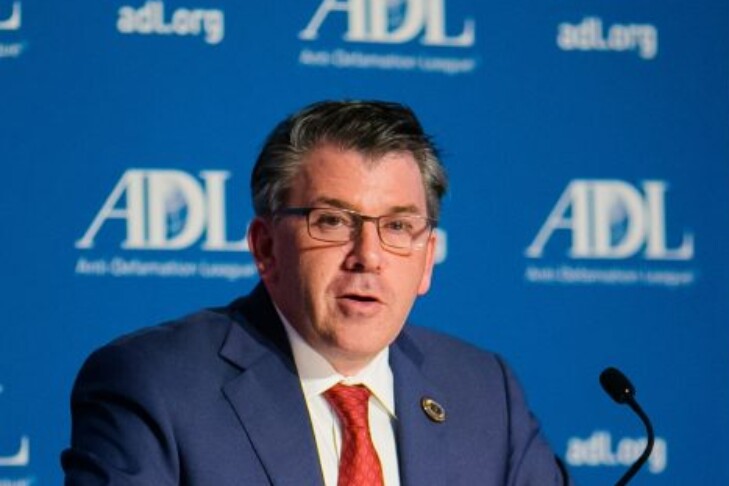For nearly a decade, Robert Trestan has headed the Anti-Defamation League New England. In that span, he’s confronted antisemitism while seeking partnerships with the larger community. Now, he takes on a new responsibility on the other side of the country (although he’s continuing to work from the Boston area), overseeing one of four divisions of the ADL as the organization’s interim vice president of the western division. He spoke with JewishBoston about the past, present and future of fighting antisemitism.
What have been the challenges of your time heading the ADL in New England?
It’s been almost 10 years, and antisemitism continues to adapt. It’s constantly evolving, which requires an evolving response. One of the challenges is making it a priority for people outside of the Jewish community. For the Jewish community, we know fighting antisemitism is a top priority. We make sure it remains a high priority for elected officials, leaders, educators—people who are across the spectrum.
What would you say have been your biggest achievements in New England?
I think we’ve made a lot of progress in keeping antisemitism at the top of the agenda, at all levels. There’s been a high focus on dealing with antisemitism in schools. We made Holocaust education a top priority—the governor just signed the law. And working in partnership with other communities—fighting antisemitism is connected to fighting racism, to fighting homophobia and other forms of hate. I prioritized engaging others in the fight against antisemitism so we’re not just doing it alone.
What have been some of the biggest challenges you’ve faced here?
The persistence of a lack of understanding of what antisemitism is and its impact. And—I don’t know if I would characterize this as a challenge or disappointment—I’m constantly amazed at how the hatred for Jews exists. [For example], the restaurant in Tiverton, Rhode Island [that posted an Anne Frank meme for which it later apologized]—it’s pretty outrageous that in 2022, we still have to combat and respond to a meme like that. The antisemitism is still there; it just keeps adjusting to technology, to the political flavor of the moment.
It’s been almost five years since the “Unite the Right” white supremacist rally in Charlottesville, Virginia. Where are we now, nationally, regarding antisemitism?
Nationally, we are at historic levels. All data shows it, not just the ADL: the FBI shows it, the ADL shows it, other organizations show it. Just look at everything that happened in the last month in Massachusetts. People need to understand that the groups that hate Jews also hate people of color, also hate immigrants, also hate people in the LGBTQ+ population—and they don’t distinguish among the political ideologies of individual Jews. They see us as Jews, and they hate us. They don’t care who we vote for or what type of synagogue we go to.
What are the best practices for combating antisemitism?
It’s calling it out, education and partnerships and relationships. Those are all critical components to combating antisemitism. We can’t ignore it. We need to hold people accountable, we need to have education at every level—police, schools, parents, elected officials—and we need to be persistent and consistent.
You mentioned antisemitism has adapted, but how has it stayed the same during your time here?
The stereotypes and conspiracies around Jews have remained constant. They haven’t changed at all—the scapegoating and the use of Holocaust analogies for political purposes. Self-serving arguments have not abated. If anything, they’ve increased.
How does the issue of Israel come into play, including misperceptions about Israel?
We’ve certainly seen a trend where people are substituting the word “Zionist” for the word “Jew,” and that’s a trend we need to pay close attention to and really fight, because we can’t make it acceptable. We can’t make it politically correct to target Zionists, and we can’t allow semantics to suddenly make antisemitism politically acceptable. Targeting Zionism is a form of antisemitism. It’s not accepted. There’s definitely a trend that’s happened in the last 10 years. Some people are seeing it as acceptable to target Zionists. It’s not.
You have a background as a public defender in Florida. What originally drew you to work with the ADL?
I’ve been with the ADL for 17 years. I was a lawyer for the ADL for seven to eight years before becoming the [New England] director. My entry point was being a civil rights counselor. I’ve never worked in the for-profit world. I’ve only worked in government and nonprofits. I’m at home in this space.
What have you liked most about your job in New England?
It’s both stimulating and inspiring, and it provides a solid opportunity for change and impact.
Every time I go into Boston, there’s the Leonard P. Zakim Bunker Hill Memorial Bridge. What’s Lenny Zakim’s legacy at the ADL?
Lenny serves as the inspiration, the foundation, for much of my work. In my office, at my desk, there’s Lenny’s constitutional law book from when he went to law school. I keep a couple of Lenny’s books. His name is handwritten on the inside of his books. I keep those books above my desk, always, as a reminder of the work he did. It’s always helped me stay grounded. Lenny’s legacy serves as the backdrop for all of the work that we’ve done.



